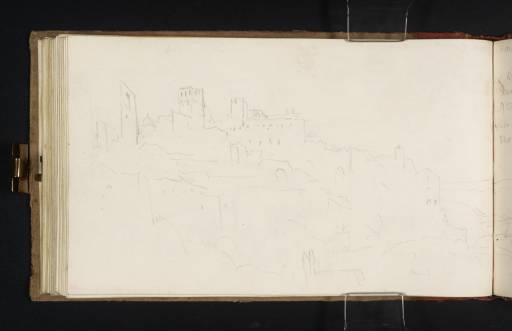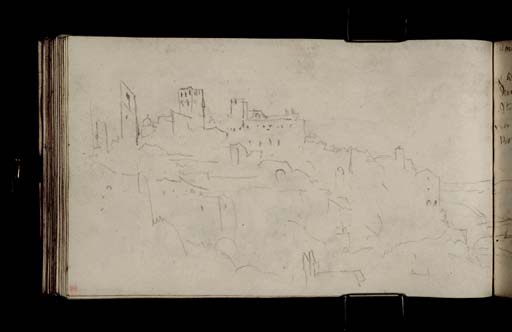Joseph Mallord William Turner Narni from the East 1819
Image 1 of 2
Joseph Mallord William Turner,
Narni from the East
1819
Joseph Mallord William Turner 1775–1851
Folio 59 Verso:
Narni from the East 1819
D14768
Turner Bequest CLXXVII 59 a
Turner Bequest CLXXVII 59 a
Pencil on white wove paper, 110 x 186 mm
Accepted by the nation as part of the Turner Bequest 1856
References
1909
A.J. Finberg, A Complete Inventory of the Drawings of the Turner Bequest, London 1909, vol.I, p.522, as ‘Narni; two sketches’.
1984
Cecilia Powell, ‘Turner on Classic Ground: His Visits to Central and Southern Italy and Related Paintings and Drawings’, unpublished Ph.D thesis, Courtauld Institute of Art, University of London 1984, pp. 101, 469 note 143.
1987
Cecilia Powell, Turner in the South: Rome, Naples, Florence, New Haven and London 1987, p.34.
2008
James Hamilton, Nicola Moorby, Christopher Baker and others, Turner e l’Italia, exhibition catalogue, Palazzo dei Diamanti, Ferrara 2008, pp.44, 90 note 29.
2009
James Hamilton, Nicola Moorby, Christopher Baker and others, Turner & Italy, exhibition catalogue, National Galleries of Scotland, Edinburgh 2009, pp.42, 150–1 note 29.
The town of Narni occupies the crest of a hill approximately seven miles south-west of Terni, and fifty miles north of Rome. As was often the case during Turner’s travels, his mode of travelling did not give him much opportunity to stop and explore the centre of the town. The carriage simply followed a predetermined course in an anti-clockwise direction from east to south-west around the walled perimeter. Consequently Turner’s sketches of Narni only relate to views or subjects visible from the road such as the edges of the town and the Bridge of Augustus in the gorge below.
The subject of this sketch is the skyline of Narni as seen from the road just outside of the walls near the Porta Ternana, the eastern gate of the town. The identifiable buildings include, from left to right: the medieval tower near the fountain in the Piazza Garibaldi; the Torre Campanaria; the Arco Romano; and the Complesso di San Francesco. On the right-hand side of the view the hill slopes away with the River Nera twisting a course through the valley below. John Chetwode Eustace described the ‘romantic appearance’ of Narni in A Classical Tour Through Italy, first published 1813:
Its walls and towers spread along the uneven summit, sometimes concealed in groves or cypress, ilex and laurel, and sometimes emerging from the shade, and rising above their waving tops; delightful views of the vales, towns, rivers and mountains, opening here and there unexpectedly on the eye; a certain loneliness and silence, even in the streets; the consequence and sad memorial of ages of revolution, disaster, and suffering, are all features pleasing and impressive.1
Today the road skirting the walls is no longer in use and the picturesque beauty of the view has been completely transformed by the industrialisation of the area around the new town of Narni Scalo. The drawing continues on the opposite sheet of the double-page spread, see folio 60 (D14769).
Nicola Moorby
November 2008
How to cite
Nicola Moorby, ‘Narni from the East 1819 by Joseph Mallord William Turner’, catalogue entry, November 2008, in David Blayney Brown (ed.), J.M.W. Turner: Sketchbooks, Drawings and Watercolours, Tate Research Publication, December 2012, https://www


